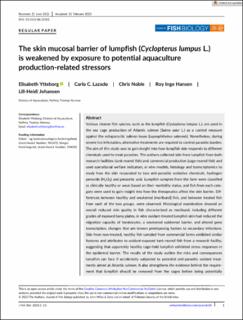| dc.description.abstract | Various cleaner fish species, such as the lumpfish (Cyclopterus lumpus L.), are used in the sea cage production of Atlantic salmon (Salmo salar L.) as a control measure against the ectoparasitic salmon louse (Lepeophtheirus salmonis). However, during severe lice infestation, alternative treatments are required to control parasitic burden. The aim of this study was to gain insight into how lumpfish skin responds to different chemicals used to treat parasites. We collected skin from lumpfish from both research facilities (tank reared fish) and commercial production (cage reared fish), and used operational welfare indicators (OWIs), in vitro models, histology and transcriptomics to study how the skin responded to two anti-parasitic oxidative chemicals, hydrogen peroxide (H2O2) and peracetic acid (PAA). Lumpfish sampled from the farm were classified as clinically healthy or weak according to their morbidity status, and fish from each category were used to gain insight into how the therapeutics affect the skin barrier. Differences between healthy and weakened (moribund) fish, and between treated fish from each of the two groups, were observed. Histological examination showed an overall reduced skin quality in fish characterized as moribund, including different grades of exposed bony plates. In vitro oxidant-treated lumpfish skin had reduced migration capacity of keratocytes, a weakened epidermal barrier and altered gene transcription, changes that are known predisposing factors to secondary infections. Skin from non-treated, healthy fish sampled from commercial farms exhibited similar features and attributes to oxidant-exposed tank reared fish from a research facility, suggesting that apparently healthy cage-held lumpfish exhibited stress responses in the epidermal barrier. The results of the study outline the risks and consequences lumpfish can face if accidentally subjected to potential anti-parasitic oxidant treatments aimed at Atlantic salmon. It also strengthens the evidence behind the requirement that lumpfish should be removed from the cages before being potentially exposed to this type of treatment and outlines the potential risks of differing husbandry practices upon lumpfish health, welfare and resilience. | |
